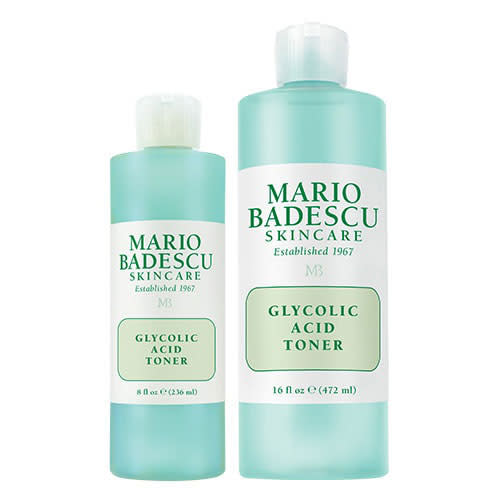
Do you struggle with acne or wrinkles and are looking for something to reverse its effects on your skin? As one of the most popular of the alpha-hydroxy acids or AHAs, glycolic acid is derived from sugar cane and is a natural exfoliator that works wonders on a variety of skin concerns.7 It has the smallest molecular structure of all AHAs which means it has the ability to go deeper into the skin and can get right into the very small spaces surrounding dead cells.3 Rather than buffing away these dead skin cells, glycolic acid works by loosening and dissolving the glue that is holding these cells onto the stratum corneum (top layer of the skin) which allows these dead cells to shed more easily.3 This increase in cell turnover also stimulates collagen production, which is why the skin looks so smooth and plump following a glycolic acid treatment.3
This process may sound like it can generate a bit of pain and be drying for the skin, but when used properly and at safe concentrations, glycolic acid can get to work relatively unnoticed.2 It is often used in products like peels, cleansers and moisturizers that work to correct various skin problems including everything from acne and hyper pigmentation to lack-lustre skin and wrinkles.2 Darkened skin cells caused by UV damage, excess dead cells blocking the pores and too many surface skin cells that dull the complexion are all removed and taken care of by glycolic acid.1
While glycolic acid is generally a safe product, if you use concentrations that are too high for your skin, you may experience burning, redness and swelling of the skin, or crusty scabs that may cause scarring.6 The biggest danger would have to be acid burns on the skin as the low pH level of the acid reacts with the pH of the skin and triggers a dermal response to promote the production of collagen and increase cell renewal.6 This is most likely to happen by using an at home glycolic acid peel with a concentration that is too high for the skin, or leaving it on for too long.5 This may result in the need for medical attention or a few days of rest.5
While it may seem obvious for most, it is extremely important that you try your best to keep glycolic acid away from your eyes. In the event that it comes in contact with your eyes, seek medical attention immediately as you may experience chemical burns on your eyes, stinging and a loss of vision.3 It is also important that you do not inhale this product as it may cause a shortness of breath, coughing and wheezing.3
Due to the fact that it is an acid, it is with utmost important that you choose the right concentration and apply it correctly to avoid your skin reacting negatively. The higher the concentration of glycolic acid, the more intensive the product is going to be, so you need to consider your skin type if you want to get the best results. Lower concentrations such as 10% are more suitable for sensitive skins whereas higher concentrations of 50% or higher are more suited to glycolic acid users with tougher, thicker or less sensitive skin types.4 If you apply a peel or product with concentration higher that 50%, you may need to visit a clinic as a high strength peel is only used to treat very severe skin problems and must be administered by a professional.4
As previously stated, when first applied to the skin, it is likely that you will experience a tingling sensation as the acid gets to work.5As you use glycolic acid based products more and more you will will not notice this happening as much as your skin will have become used to the process.5 However if you continue to experience a strong stinging sensation with every application then stop using the product immediately as it may be causing your skin more damage than it should.4
Glycolic acid can also make the skin sensitive to the sun, so it is important that you always wear a high factor sunscreen (I would recommend SPF 30 or greater) for the days following a treatment 2 or the use of a glycolic acid based product, If you are doing an at-home peel then it is better to perform the treatment in the evening, that way your skin has all night to recover and you will wake up with smoother, clearer skin.
This comment has been removed by the author.
ReplyDelete